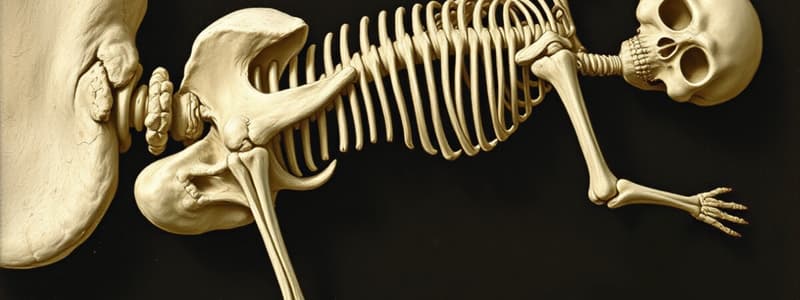Podcast
Questions and Answers
What are the six functions of bone tissue?
What are the six functions of bone tissue?
Support, Protection, Assist in movement, Mineral homeostasis, Production of blood cells, Triglyceride storage.
Classify bones according to their shape.
Classify bones according to their shape.
- Short bones (correct)
- Long bones (correct)
- Flat bones (correct)
- Irregular bones (correct)
List the major features of a long bone.
List the major features of a long bone.
Diaphysis, Epiphyses, Metaphyses, Epiphyseal line, Periosteum, Endosteum, Medullary cavity, Yellow marrow, Red marrow, Articular cartilage.
What are the microscopic structures of bone tissue?
What are the microscopic structures of bone tissue?
What is the Haversian System?
What is the Haversian System?
Describe spongy bone.
Describe spongy bone.
What is ossification?
What is ossification?
What is endochondral ossification?
What is endochondral ossification?
What is intramembranous ossification?
What is intramembranous ossification?
Flashcards are hidden until you start studying
Study Notes
Functions of Bone Tissue
- Supports soft tissues and provides muscle attachment sites, acting as the body's structural framework.
- Protects vital internal organs with bony encasements.
- Assists in movement through the work of skeletal muscles.
- Maintains mineral homeostasis by storing and releasing minerals, primarily calcium and phosphorus.
- Facilitates blood cell production, known as hemopoiesis, occurring in red marrow.
- Serves as a triglyceride storage site in the yellow marrow of adults.
Classification of Bones
- Long bones: Shaft with two ends; examples include femur (thigh) and humerus (upper arm).
- Short bones: Cube-like structure; wrist bones (carpals) and ankle bones (tarsals) are examples.
- Flat bones: Thin and curved; includes skull bones and ribs.
- Irregular bones: Do not fit into other categories; examples include vertebrae.
Major Features of a Long Bone
- Diaphysis: Shaft of the long bone.
- Epiphyses: Ends of the bone.
- Metaphyses: Region between epiphysis and diaphysis, includes epiphyseal plate in growing bones.
- Articular Cartilage: Hyaline cartilage at bone ends, reducing friction and absorbing shock at joints.
- Periosteum: Connective tissue covering the bone, protecting it and aiding in repair and nourishment.
- Medullary Cavity: Inner space of the diaphysis containing marrow.
- Yellow Marrow: Area for fat storage.
- Red Marrow: Site for blood cell production.
- Endosteum: Lining of the medullary cavity.
Microscopic Structures of Bone
- Bone tissue consists of cells widely separated by a significant matrix.
- Types of bone cells:
- Osteogenics: Precursor cells for bone formation.
- Osteoblasts: Bone-building cells.
- Osteocytes: Mature bone cells, crucial for maintaining bone tissue.
- Osteoclasts: Cells derived from monocytes that break down bone tissue.
- Bone matrix contains inorganic salts, primarily hydroxyapatite, calcium carbonate, and collagen fibers, important for bone hardness and tensile strength.
- Calcification occurs in the presence of collagen fibers.
Haversian System in Compact Bone
- Compact bone is organized into osteons (Haversian systems) that house blood vessels, lymphatic vessels, nerves, and osteocytes.
- Osteons are aligned along lines of stress, which can shift with changes in mechanical stress on the bone.
Spongy Bone and Trabeculae
- Spongy (cancellous) bone lacks osteons and is composed of trabeculae (bone columns or beams) that create spaces filled with red marrow.
- Forms the internal structure of short, flat, irregular bones, and epiphyses of long bones.
- Provides lightness while supporting and protecting red bone marrow.
Ossification
- Ossification (or osteogenesis) refers to the formation of bone, starting with mesenchymal cells forming a template.
Endochondral Ossification
- Involves bone formation from hyaline cartilage models, replacing cartilage with bone, essential for forming most body bones.
Intramembranous Ossification
- Formation of bone directly from mesenchymal tissue, typically resulting in flat bones such as those of the skull and clavicles.
Studying That Suits You
Use AI to generate personalized quizzes and flashcards to suit your learning preferences.




